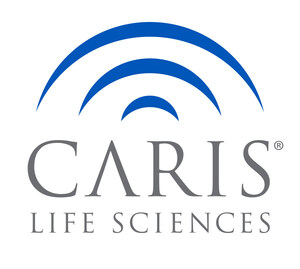Caris Molecular Intelligence® Identifies Targeted Treatment Options for Patients with Wild-type Tumors for Common Drivers
ASCO Presentations Shed Light on Biomarkers for Rare and Resistant GIST Subtypes and for Triple Wild-type Melanoma
IRVING, Texas, May 28, 2015 /PRNewswire/ -- Caris Life Sciences, a leading biotechnology company focused on fulfilling the promise of precision medicine, today announced the presentation of data from two studies that demonstrate the utility of Caris Molecular Intelligence®, the company's panomic comprehensive tumor profiling service, in helping to identify targeted treatment options for patients with rare tumors that are wild-type for all known oncogenic drivers. The two studies, presented in poster sessions at the annual meeting of the American Society of Clinical Oncology (ASCO) in Chicago, Ill., shed light on biomarkers that appear to be actionable therapeutic targets for rare and resistant subtypes of gastrointestinal stromal tumors (GISTs) and for triple wild-type melanoma, respectively.
Caris Molecular Intelligence is a multi-platform tumor profiling service that includes gene sequencing (Next-Generation Sequencing [NGS] and Sanger), protein expression analysis (Immunohistochemistry [IHC]), gene copy number and translocation analysis (Chromogenic or Fluorescence in situ Hybridization [CISH or FISH]). Investigators used these methods to examine tumor samples for patterns of biomarker expression that may yield insights into selection of novel therapeutic options for patients with rare, resistant GIST and triple wild-type melanoma.
"Whereas genetic mutations draw considerable attention as drivers of various cancers, the fact remains that some tumor types are not mutation-driven, but are considered 'wild-type,'" said Sandeep K. Reddy, MD, Chief Medical Officer at Caris Life Sciences. "Our latest research suggests that Caris Molecular Intelligence can greatly aid oncology researchers and practicing clinicians in detecting actionable biomarkers as therapeutic targets for wild-type tumors, as well as for mutation-driven tumors."
Rare and Resistant GIST Study
In a May 31st poster presentation (abstract #10539), researchers will describe how they used Caris Molecular Intelligence to analyze biomarkers in 217 GIST samples as a means to identify novel therapeutic options. "GISTs are predominantly defined by activating mutations in the KIT or PDGFRA genes, which are targetable with TKIs. However, most such tumors become TKI-resistant," explained lead investigator Michael J. Pishvaian, MD, PhD, Assistant Professor in the Department of Hematology/Oncology at the Lombardi Comprehensive Cancer Center at Georgetown University in Washington, D.C. "Patients with double wild-type GISTs, whose tumors lack mutations in KIT and PDGFRA, constitute a very rare subpopulation of GIST patients in great need of targeted treatment options. By using a multiplatform approach to interrogate theranostic biomarkers, we identified several potential non-cKIT/PDGFRA therapies for rare and resistant GIST."
Dr. Pishvaian and colleagues assessed 19 double wild-type (D-WT) and 24 TKI-resistant (TKI-R) GIST cases for additional targetable alterations. The TKI-R cases included seven with resistance mutations in the absence of a primary activating KIT mutation, and four with the PDGFRA D842V mutation, which is known to be associated with TKI resistance. IHC and ISH tests revealed no overexpression or amplification of the cMET, or HER2 proteins. The tumor suppressor protein PTEN was intact (positive expression) in the majority of GISTs, including 88% (15/17) of D-WT and 100% (20/20) of TKI-R GISTs. Mutational screening of 47 genes (excluding cKIT and PDGFRA) revealed variants in PIK3CA, ABL, cMET, JAK3, RB1, and VHL; a minority of these are potentially targetable with therapies that are either commercially available or being investigated in clinical trials. Mutations in ABL and JAK3 were exclusively found in the TKI-R subgroup. The investigators detected tumor infiltrating lymphocytes that were positive for the programmed cell death protein 1 (PD-1) in 33% (1/3) of D-WT and in 60% (3/5) of TKI-R GISTs, while tumor expression of the PD-1 ligand (PD-L1) was observed in 67% (2/3) of D-WT and in 40% (2/5) of TKI-R cases.
Although chemotherapy has historically elicited poor responses in GIST, the investigators reported a high frequency of low expression of predictive markers for gemcitabine (RRM1, 77% in D-WT and 85% in TKI-R GISTs) and paclitaxel (TUBB3, 58% in D-WT and 75% in TKI-R), as well as a high frequency of topoisomerase 1 (TOPO1) overexpression for irinotecan (53% and 30% in D-WT and TKI-R, respectively). Dr. Pishvaian noted that these types of agents were recently shown to be cytotoxic in TKI-R GIST cell lines. In this patient population in desperate need of additional therapies, researchers also noted that it would be worthwhile to explore whether the development of TKI-resistance has re-sensitized these tumors to more classic, cytotoxic chemotherapies.
"Biomarker analysis helped us identify potential treatments for patients with double wild-type GIST, as well as for patients who have acquired TKI resistance after experiencing disease progression while on imatinib therapy," commented Dr. Pishvaian. "Our results suggest there are numerous opportunities for investigating new targeted agents and for potentially revisiting the use of cytotoxic chemotherapy with biomarker guidance in these GIST subpopulations."
Triple Wild-type Melanoma Study
In a poster to be presented on June 1 (abstract #9054), researchers compared the molecular and PD-L1 profiles of melanoma patients whose tumors harbor mutations in the BRAF, NRAS, and cKIT genes, to those with so-called triple wild-type melanoma, meaning that their tumors lack mutations in those genes. "Malignant melanoma is a genetically diverse disease, with BRAF, NRAS and cKIT mutations covering a large proportion of patients," explained lead investigator Olivier Michielin, MD, PhD, Associate Professor of Translational Oncology at CHUV (Centre Hospitalier Universitaire Vaudois) in Lausanne, Switzerland. "However, the triple wild-type subpopulation is a rare but important group of patients in dire need of potential targeted therapies."
Dr. Michielin and colleagues queried the Caris Molecular Intelligence database to analyze 542 melanoma patient samples for IHC and NGS data; 89 of these samples also had PD-L1 expression data available. The investigators grouped the samples into four subtypes: BRAF-mutated (n=169), NRAS-mutated (n=151), cKIT-mutated (n=25), and triple wild-type (n=197). Whereas cMET expression was more frequent in the BRAF-mutated and triple wild-type subgroups, NRAS-mutated tumors showed a lack of ERCC1 expression, and cKIT-mutated tumors exhibited a lack of PGP expression. All mutation subtypes presented equally frequent expression of MGMT, SPARC, TOP2A, TOPO1, TS, TUBB3 and RRM1, suggestive of multiple chemoresistance pathways. TP53 mutations were recurrent (approximately 15%) in all mutation subgroups. In triple wild-type tumors, a different spectrum of mutations arose with low frequency (<10%). Mutant KRAS, JAK3, cMET, GNA11, GNAQ, APC, KDR, BRCA1, and ERBB4 defined actionable lesions in up to 40% of triple wild-type patients. None of the 541 tumors presented mutations in Akt, BRCA2, IDH1, CSF1R, GNAS, Notch1, Smo, STK11, VHL, MLH1, MPL, or MPM1.
Whereas a PD-L1 subanalysis showed an overall 75% PD-L1 positivity, triple wild-type tumors were more frequently PD-L1-negative, suggesting that PD-L1 inhibitor therapy would not be effective in most triple wild-type patients. Patients with PD-L1-negative tumors were 2.5-fold more likely to have TUBB3 overexpressed.
"Triple wild-type melanomas appear to be more heterogeneous than tumors with BRAF, NRAS, and cKIT mutations," commented Dr. Michielin. "Low-frequency mutations can identify targets in up to 40% of patients, while triple wild-type tumors are less frequently PD-L1-positive. Overall, patients with triple wild-type melanoma should be tested for multiple biomarkers in order to identify low-frequency but potentially actionable mutations as therapeutic targets."
About Caris Life Sciences®
Caris Life Sciences® is a leading biotechnology company focused on fulfilling the promise of precision medicine through quality and innovation. Caris Molecular Intelligence®, the company's healthcare information and comprehensive tumor profiling service with more than 70,000 patients profiled, provides oncologists with the most clinically actionable treatment options available to personalize cancer care today. Using a variety of advanced profiling technologies to assess relevant biological changes in each patient's tumor, Caris Molecular Intelligence connects biomarker data generated from a tumor with biomarker-drug associations supported by evidence in the relevant clinical literature. Since 2009, Caris has tracked clinical and outcome data for certain patients undergoing tumor molecular profiling, for which Caris has observed that patients treated with drugs consistent with their molecular profile show a significant increase in overall survival. The company is developing its Carisome® TOP™ technology, a revolutionary and proprietary blood-based platform for the development of novel therapeutics, drug delivery and drug target identification. The technology is also being developed for diagnosis, prognosis, and theranosis of cancer and other complex diseases. Headquartered in Irving, Texas, Caris Life Sciences offers services throughout Europe, the U.S., Australia and other international markets. To learn more, please visit www.CarisLifeSciences.com.
SOURCE Caris Life Sciences
Related Links
http://www.carislifesciences.com
WANT YOUR COMPANY'S NEWS FEATURED ON PRNEWSWIRE.COM?
Newsrooms &
Influencers
Digital Media
Outlets
Journalists
Opted In






Share this article